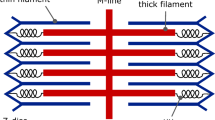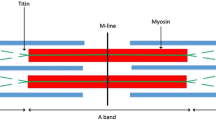Summary
One component of the dynamic response of muscle spindles is characterized by a phase lead and frequency dependent sensitivity in response to sinusoidal stretches at frequencies around 1 Hz. Possible mechanisms producing this component, designated the “mid-frequency” dynamics, were investigated by testing the hypotheses that they arise from the mechanical behavior of the intrafusal muscle and alternatively from within the sensory terminals. Destruction of the myofibrillar structure of the intrafusal muscle fibers did not alter the mid-frequency dynamics, indicating that they do not arise from viscoelastic properties of the intrafusal muscle. An Arrhenius plot of the temperature dependence of the mid-frequency dynamics yielded an equivalent activation energy of 6.5 Kcal/M in the temperature range 23–42° C and a 3-fold higher activation energy at lower temperatures. These observations are consistent with a dynamic process associated with a membrane-bound bio-chemical process. The addition of Ca++ and Ca++-activated-K+ (K(Ca)) channel blockers (ZnCl2, Apamin and TEA) to the bathing solution altered the response dynamics by reducing the mid-frequency phase lead. The results suggest a negative feedback on the membrane potential generated by K++ efflux following a Ca++ influx that opens K(Ca) channels. A quantitative model fit to the experimental data yields a time constant of about 80 ms representing the limiting process associated with activation of the K(Ca) channels in this system. The results indicate that the mechanism underlying the mid-frequency dynamics includes at least two processes: one, not identified in this study, generates the phase lead and another, involving Ca++ and K(Ca) channels, provides a negative feedback that modifies the phase lead.
Similar content being viewed by others
References
Art JJ, Crawford AC, Fettiplace R (1986) Electrical resonance and membrane currents in turtle cochlear hair cells. Hearing Res 22:31–36
Art JJ, Crawford AC, Fettiplace R, Fuchs PA (1985) Efferent modulation of hair cell tuning in the cochlea of the turtle. J Physiol 360:397–421
Banks RW, Barker D, Stacey MJ (1982) Form and distribution of sensory terminals in cat hindlimb muscle spindles. Philos Trans R Soc Lond B 299:329–364
Boyd IA, Smith RS (1984) The Muscle Spindle. In: Peripheral neuropathy. Dyck PJ, Thomas PK, Lambert EH, Bunge R (eds) WB Saunders Co, Philadelphia
Brown MC, Engberg I, Matthews PBC (1967) The relative sensitivity to vibration of muscle receptors of the cat. J Physiol 192:773–800
Chen WJ, Poppele RE (1978) Small signal analysis of response of mammalian muscle spindles with fusimotor stimulation and a comparison with large signal responses. J Neurophys 41:15–27
Crozier WJ (1926) The distribution of temperature characteristics for biological processes; critical increments for heart rates. J Gen Physiol 9:531–546
Grisham CM, Barnett RE (1973) The role of lipid-phase transitions in the regulation of the (sodium and potassium) adenosine triphosphatase. Biochemistry 12:2635–2637
Gregory JE, Morgan DL, Proske U (1986) Aftereffects in the responses of cat muscle spindles. J Neurophysiol 56:451–461
Hagiwara S, Byerly L (1981a) Calcium channels. Ann Rev Neurosci 4:69–125
Hagiwara S, Byerly L (1981b) Membrane biophysics of calcium currents. Fed Proc 40:2220–2225
Hille B (1984) Ionic channels of excitable membranes. Sinauer Assoc Inc, Sunderland, MA
Hudspeth AJ (1985) The cellular basis of hearing: the biophysics of hair cells. Science 230:745–752
Hugues M, Romey G, Duval D, Vincent JP, Lazdunski M (1982)Apamin as a selective blocker of Ca2+ dept-K+-channel in neuroblastoma cells: voltage-clamp and biochemical characterization of the toxin receptor. Proc Natl Acad Sci USA 79:1308–1312
Hunt CC, Wilkinson RS (1980) An analysis of receptor potential and tension of isolated cat muscle spindles in response to sinusoidal stretch. J Physiol 302:241–262
Hunt CC, Wilkinson RS, Fukami Y (1978) Ionic basis of the receptor potential in primary endings of mammalian muscle spindles. J Gen Phys 71:683–698
Kruse MN, Poppele RE (1985) Temperature dependence of the dynamic behavior of muscle spindles. Soc Neurosci Abstr 11:409
Kruse MN, Poppele RE (1987) Contribution of a Ca2+ activated K+ channel to the dynamics of the muscle spindle. Soc Neurosci Abstr 13:1062
Kruse MN, Poppele RE (1989) Electrical tuning in muscle spindle receptors. Brain Res 496:303–306
Kruse MN, Quick DC (1986) Effect of intrafusal fiber damage on muscle spindle dynamics. Soc Neurosci Abstr 12:1084
Lang DG, Ritchie AK (1990) Tetraethylammonium blockade of apamin-sensitive and insensitive Ca2+-activated K+ channels in a pituitary cell line. J Physiol 425:117–132
Lazdunski M (1983) Apamin, a neurotoxin specific for one class of Ca2+ dependent K+ channels. Cell Calcium 4:421–428
Leventhal M, Tabakof B (1980) Sodium-potassium-activated adenosine triphosphatase activity as a measure of neuronal membrane characteristics in ethanol-tolerant mice. J Pharmacol Exp Ther 212(2): 315–319
Lewis RS, Hudspeth AJ (1983) Voltage- and ion-dependent conductances in solitary vertebrate hair cells. Nature 304:538–541
Matthews PBC (1964) Muscle spindles and their motor control. Physiol Rev 44:219–288
Matthews PBC, Stein RB (1969a) The sensitivity of muscle spindle afferents to small sinusoidal changes of length. J Physiol 200:723–743
Matthews PBC, Stein RB (1969b) The regularity of primary and secondary muscle spindle afferent discharges. J Physiol 202:59–82
McKean TA, Poppele RE, Rosenthal NP, Terzuolo CA (1970) The biologically relevant parameter in nerve impulse trains. Kybernetik 6:168–170
Nemat-Gorgani M, Meisami E (1979) Use of Arrhenius plots of Na-K ATPase and acetylcholinesterase as a tool for studying changes in lipid-protein interactions in neuronal membranes during brain development. J Neurochem 32:1027–1032
Overath P, Trauble H (1973) Phase transitions in cells, membranes, and lipids of Escherichia coli. Detection by fluorescent probes, light scattering, and dilatometry. Biochemistry 12:2625–2634
Pallotta BS (1985) Calcium-activated potassium channels in rat muscle inactivate from a short-duration open state. J Physiol 363:501–516
Poppele RE (1973) Systems approach to the study of muscle spindles. In: Stein RB, Pearson KG, Smith RS, Redford JB (eds) Control of posture and locomotion. Plenum Press, New York
Poppele RE, Bowman RJ (1970) Quantitative description of linear behavior of mammalian muscle spindles. J Neurophys 33:59–72
Poppele RE, Chen WJ (1972) Repetitive firing behavior of mammalian muscle spindles. J Neurophysiol 35:357–364
Poppele RE, Kennedy W, Quick DC (1979) A determination of static mechanical properties of intrafusal muscle in isolated cat muscle spindles. Neuroscience 4:401–411
Poppele RE, Quick BC (1985) Effect of intrafusal muscle mechanics on mammalian muscle spindle sensitivity. J Neurosci 5:1881–1885
Poppele RE, Quick DC (1981) Stretch-induced contraction of intrafusal muscle in cat muscle spindle. J Neurosci 1:1069–1074
Quick DC, Kennedy WR, Poppele RE (1980) Anatomical evidence for multiple sources of action potentials in the afferent fibers of muscle spindles. Neuroscience 5:109–115
Quick DC, Kennedy WR, Donaldson L (1979) Dimensions of myelinated nerve fibers near the motor and sensory terminals in cat tenuissimus muscles. Neuroscience 4:1089–1096
Stanfield PR (1983) TEA Ions and the K+-permeability of excitable cells. Rev Physiol Biochem Pharmacol 97:2–67
Vincent JP, Schweitz H, Lazdunski M (1975) Structure-function relationship and site of action of apamin, a neurotoxic polypeptide of bee venom with an action on the central nervous system. Biochemistry 14:2521–2525
Woolum JC, Gorman ALF (1981) Time dependence of the calciumactivated potassium current. Biophys J 36:297–302
Author information
Authors and Affiliations
Rights and permissions
About this article
Cite this article
Kruse, M.N., Poppele, R.E. Components of the dynamic response of mammalian muscle spindles that originate in the sensory terminals. Exp Brain Res 86, 359–366 (1991). https://doi.org/10.1007/BF00228959
Received:
Accepted:
Issue Date:
DOI: https://doi.org/10.1007/BF00228959




